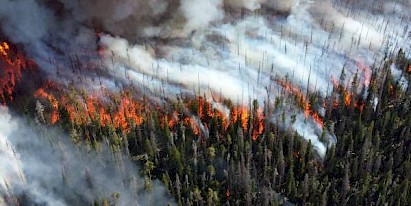How wildfire smoke and resulting poor air quality impact your health
 Dark plumes of smoke from wildfires scorching Nova Scotia are drifting down the northeast corridor, leaving behind a pungent aroma and prompting health authorities to issue air-quality warnings as far east as New Jersey, southeast Pennsylvania and parts of Massachusetts.
Dark plumes of smoke from wildfires scorching Nova Scotia are drifting down the northeast corridor, leaving behind a pungent aroma and prompting health authorities to issue air-quality warnings as far east as New Jersey, southeast Pennsylvania and parts of Massachusetts.
The resulting hazy skies have contributed to spectacular sunsets — such as the “Manhattanhenge” that wowed New Yorkers on Tuesday evening. But the fires have damaged more than 200 homes in Nova Scotia and forced more than 16,000 people to flee. They have also fouled the air for millions on the East Coast, as has a fire burning in New Jersey, which has contributed to Washington D.C.’s smoky skies.
It took only one day for the smoke from the Nova Scotia fire, which started on Sunday, to travel to Boston roughly 500 kilometers away, according to Hiren Jethva, a senior research scientist at Morgan State University affiliated with NASA’s Goddard Space Flight Center.
Smoke particles can be blown across vast distances, according to Francesca Dominici, a professor of Biostatistics, Population and Data Science at Harvard’s school of public health.
“The wildfire smoke can travel from the West Coast to the East Coast. And now we’re seeing also wildfire smoke coming from Canada back to the U.S., too,” she said.
Here’s what you need to know about the health effects of wildfire smoke and how to protect yourself on days with poor air quality.
What are the components of wildfire smoke?
Wildfire smoke contains fine particulates, commonly known as PM2.5, that are often unseen components of smoke and soot.
These fine particles come directly from wildfire smoke, and tend to be “more toxic than other sources of PM2.5” because wildfires burn everything, Dominici said. This includes various household materials, such polyvinyl piping and batteries, that produce toxic emissions when combusted.
What are the health risks and symptoms of smoke exposure?
The particulates are so small that they can be inhaled through your lungs and enter the bloodstream. Exposure can trigger short-term respiratory problems such as coughing, wheezing, difficulty breathing and asthma exacerbation, according to Dominici. Breathing in smoke can also irritate your sinuses, throat and eyes, according to the Centers for Disease Control and Prevention.
In more severe cases, exposure is linked with cardiovascular impacts — including heart attacks and stroke — as well as lung cancer and damage to cognitive functions.
Who is more vulnerable to smoke exposure?
Everyone is vulnerable to the risks posed by wildfire smoke — even healthy people, according to the CDC. But some people are more affected than others.
The elderly face some of the greatest risk due to their body’s inability to fight against cardiovascular and respiratory inflammation caused by PM2.5, coupled with other conditions, Dominici said. Limited mobility could also increase risk.
“They may have less ability to move away from the area and be able to protect themselves,” Dominici said.
Young children, people with preexisting cardiovascular or respiratory disease or who are pregnant also face significant risks.
Race and socio-economic status can increase vulnerability. Research conducted by Harvard show that Black, Asian, Hispanic, Latino and low-income populations are exposed to fine-particulate pollution far more than people of other groups.
Often, lower-income individuals aren’t able to evacuate during wildfire season and can’t afford expensive filtration equipment to shelter in place, Dominici said. Many low-income individuals are front-line workers as well.
Is it safe to breathe smoke? And in what quantities?
The National Ambient Air Quality Standard recommended maximum exposure to PM2.5 is an annual mean of 12 micrograms per cubic meter of air and 35 micrograms per cubic meter in a 24-hour period.
But experts believe that 35 micrograms per cubic meter daily is still too high.
In Dominici’s view, the federal government’s short- and long-term standards are not protective enough and “need to be lowered.”
“The evidence says that they should be as low as possible and that there is not a ‘safe’ level,” she added.
The Environmental Protection Agency recently proposed making the new annual recommendation between the range of 9 to 10 micrograms per cubic meter.
What can people do?
The messaging to people exposed to bouts of poor air quality is simple:
- Limit your exposure and stay inside. “If there is a wildfire in your area and there’s a lot of smoke in the air, the best thing you can do is try to stay away as much as possible, staying indoors and have an air purifier if you can,” Dominici said.
- Exercise indoors. “Your inhalation rate is much higher [when you’re exercising] than when you’re sitting in an office or at home. When you exercise, you’re breathing more so you’re inhaling more and more particles,” Jethva said.
- Be aware of your local air quality. There are numerous apps and websites that provide real-time data on air quality. Just ask Dr. Google (or other search engines).
- Wear a mask. But not just any mask. Since fine particulate matter are so tiny, the standard mask won’t block them out. “A sophisticated mask that can filter out these particles would work,” Jethva said.
Filter is the key word. Masks can’t completely shield you from the toxic particles released from wildfires.
You can return to the main Market News page, or press the Back button on your browser.

